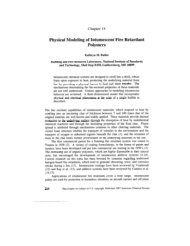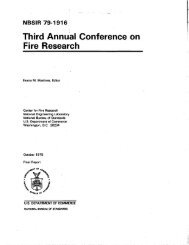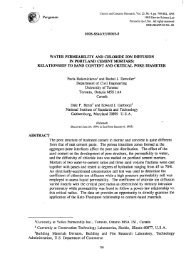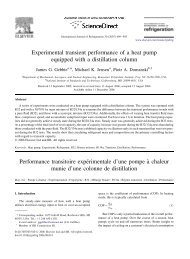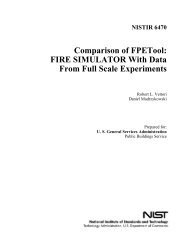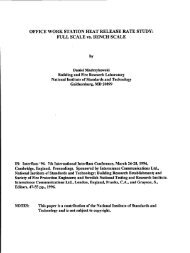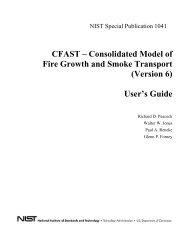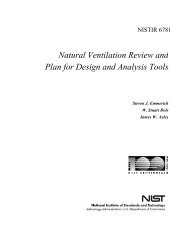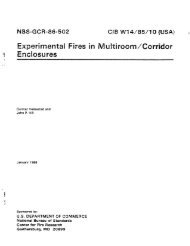Study of Technology for Detecting Pre-Ignition Conditions of ... - NIST
Study of Technology for Detecting Pre-Ignition Conditions of ... - NIST
Study of Technology for Detecting Pre-Ignition Conditions of ... - NIST
Create successful ePaper yourself
Turn your PDF publications into a flip-book with our unique Google optimized e-Paper software.
CPSC-IAG95-1145<br />
Appendix A also contains a section on fuzzy logic, artificial intelligence, and smart sensors as<br />
applied to multi-parameter detection. The algorithms and hardware can range from simple to<br />
.<br />
very sophisticated and would depend on the final design <strong>of</strong> the detector. The number <strong>of</strong> inputs<br />
.“ to the smart system and how they should be interpreted would impact the complexity and cost<br />
<strong>of</strong> the detector. Costs <strong>of</strong> the individual components have not been assembled because they are<br />
. ,. so dependent on actual design and application.<br />
4.3.2 Controls<br />
Very few <strong>of</strong> the documents found in the NTIS and EI databases were directly related to<br />
the needed technology, but many <strong>of</strong> the patents were similar to or exactly the kinds <strong>of</strong> controls<br />
being sought. Several <strong>of</strong> the patents are <strong>for</strong> power disruption devices designed <strong>for</strong> smoke or fire<br />
ahum input. Other patents are <strong>for</strong> gas safety valves with detector inputs. Brochures that were<br />
obtained from companies advertise similar technology to that which was sought. The technology<br />
<strong>for</strong> shutting down gas and electric ranges as ignition conditions are approached is readily<br />
available and is relatively inexpensive since much <strong>of</strong> it is mass produced <strong>for</strong> application to ranges<br />
and other appliances.<br />
5.0 Conclusions<br />
The conclusions pertaining to the experiments are based on measurements and<br />
observations <strong>of</strong> combinations <strong>of</strong> specific ranges, pans, foods, and ventilation so extrapolation to<br />
other condhions should be pefiormed with caution. The conclusions <strong>of</strong> this research are as<br />
follows:<br />
● Food cooked in a stainless steel pan more quickly reached ignition conditions than the<br />
same food cooked in an aluminum pan.<br />
● For the particular open-coil element electric and high-output gas ranges used in these<br />
experiments, food cooked on the electric range reached ignition conditions more quickly<br />
than the same food cooked on the gas range with the exception <strong>of</strong> sugar which reached<br />
ignition conditions more quickly on the gas range.<br />
● For the particular ranges used in these experiments, cooking food on the electric range<br />
produced similar ignition conditions to those produced by cooking the same food on the<br />
gas range.<br />
● The temporal heating and ignition behaviors <strong>of</strong> soybean oil and bacon were simila~<br />
however, sugar had a unique behavior.<br />
● The particular range hood used was not found to have a significant effect on ignition<br />
conditions, and its active or inactive status appeared irrelevant to pre-ignition detection.<br />
● Weak indicators and non-indicators <strong>of</strong> impending ignition were velocity above the burner<br />
and infrared imaging <strong>of</strong> the cooking area.<br />
● Strong indicators <strong>of</strong> impending ignition were food, pan, range, and range-hood<br />
temperatures, smoke particulate, and hydrocarbon gases. Some pre-ignition temperature<br />
signatures will require more study since they may be mimicked by normal, safe use <strong>of</strong> the<br />
oven or multiple burners.<br />
65



